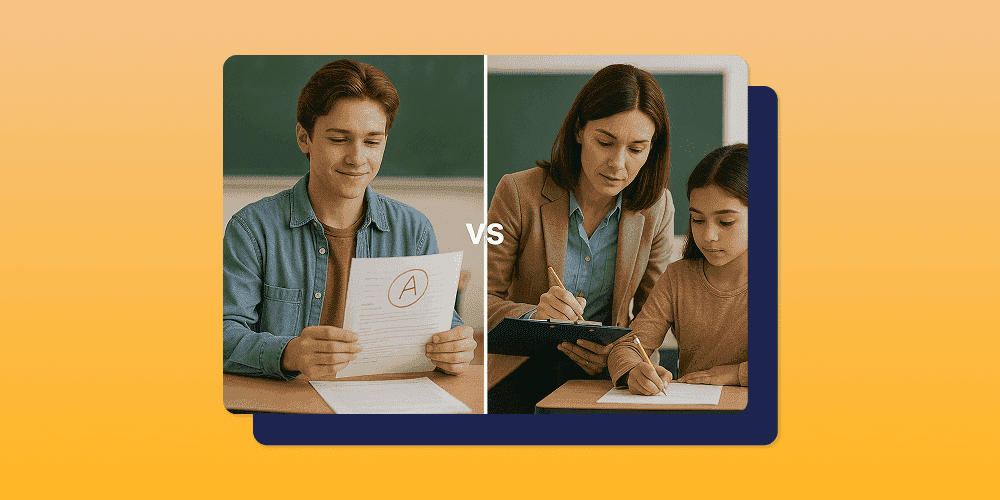
American summer tour! Wooclap will be at InstructureCon 2025
Come say hi at booth 41 from July 22nd to July 24th in Spokane, Washington
How Interactive Questions Can Boost Student Engagement in the Classroom
07.11.2024 • 5 minutes

Nowadays, engaging students has become more challenging than ever. With constant access to digital distractions and shorter attention spans, educators are rethinking traditional methods to make learning more interactive.
Using interactive questioning in the classroom ıs an effective way to capture students’ attention, deepen understanding, and foster a more dynamic learning environment.
This approach isn’t about simply asking questions. It’s more about strategically using questions to create a two-way conversation. Then students would actually participate and become part of the lesson. There are also many education platforms and digital certificate programs you can sign up to learn more about.
Platforms like Wooclap enable teachers to integrate interactive questions seamlessly into their teaching, making the experience engaging and personalized for each student. Here’s how interactive questioning can revolutionize engagement in the classroom.
The power of active learning
Active learning transforms students from passive listeners into active participants. Instead of listening passively, students engage directly with the material, improving retention and comprehension. Interactive questions play a major role here by prompting students to think critically and participate in real time.
When educators use platforms like Wooclap to present questions, quizzes, or polls throughout a lesson, they break the learning process into manageable, thought-provoking chunks. These pauses allow students to reflect, respond, and digest the material in smaller sections, which reduces information overload and boosts understanding.
Studies have shown that active learning improves retention rates compared to traditional lecture-based learning. By promoting active engagement, educators help students retain information long after they leave the classroom.
Building a Connection Through Questions
Interactive questioning goes beyond simple yes-or-no responses. Instead, it encourages students to share their thoughts, ideas, and insights. When teachers actively seek student input, it fosters a more connected classroom environment where students feel heard and valued. This connection can be pivotal, as students are more likely to engage in discussions and contribute ideas when they feel comfortable.
Platforms like Wooclap allow students to respond anonymously if desired, which can be a game-changer for shy or reluctant students. Knowing they can respond without fear of judgment makes them more likely to participate and voice their opinions. As a result, classroom discussions become more inclusive, and diverse perspectives emerge, enriching the learning experience for everyone involved.
Encouraging Critical Thinking and Problem-Solving
Interactive questions do more than gauge comprehension; they also promote critical thinking. Open-ended questions, real-life scenarios, or "what-if" questions push students to apply what they’ve learned in new and creative ways. This type of questioning challenges students to move beyond memorization and encourages them to develop problem-solving skills.
For example, teachers might present a problem and ask students to brainstorm solutions or analyze potential outcomes. These exercises not only make learning more engaging but also cultivate essential skills for real-world applications. With interactive tools like Wooclap, educators can easily present these questions, facilitating discussions that keep students actively involved in the learning process.
Instant Feedback and Adaptive Learning
One of the standout benefits of interactive questioning is the ability to gather real-time feedback. With traditional quizzes or assignments, feedback often comes after the lesson, limiting a teacher’s ability to address misunderstandings right away. However, when students answer questions throughout a lesson, teachers can gauge comprehension instantly.
Wooclap, for instance, provides educators with live insights into student responses, allowing them to adapt the lesson on the spot if necessary. If a significant portion of the class struggles with a question, it’s a sign that the material may need revisiting. On the other hand, if students are excelling, teachers can move on to more advanced topics. This adaptability ensures that no student is left behind and that every learner receives instruction at a pace that matches their understanding.
Making Learning Fun with Gamification
Gamification is another powerful tool for boosting student engagement. By transforming learning activities into games or competitions, teachers can make the process enjoyable and rewarding. Interactive questioning platforms like Wooclap offer features that allow teachers to integrate gamified elements, such as leaderboards or point systems, into their lessons.
When students can see their progress, it adds a sense of achievement and motivates them to perform their best. This approach works particularly well for younger students or those who thrive in a competitive environment. However, even in higher education, a touch of gamification can reinvigorate classroom dynamics, making learning a fun and memorable experience for everyone.
To make it even more fun, check Sertifier, a digital badging software where your students can receive badges and certificates after completing tasks/courses!
Tailoring the Classroom Experience for Every Learner
One of the greatest advantages of interactive questioning is that it supports differentiated instruction. Each student has a unique learning style, and traditional teaching methods often fail to address these differences. Interactive questioning, however, enables teachers to use a range of question types—from multiple-choice to open-ended, image-based, or even matching questions—each catering to different learning preferences.
With platforms like Wooclap, teachers can tailor questions to appeal to visual, auditory, and kinesthetic learners alike. Additionally, interactive questioning allows students to process and respond at their own pace, which is especially beneficial for students who may struggle with the pressure of fast-paced lectures.
Measuring Progress and Improving Teaching Strategies
Using data from interactive questions, teachers can gain valuable insights into student progress and areas where additional support may be needed. Over time, these insights can reveal trends, showing where students frequently encounter challenges or excel. With this information, teachers can refine their approach to better address the needs of their class.
For example, if students consistently struggle with a certain topic, teachers can dedicate more time to it or experiment with different teaching strategies. This data-driven approach to education makes teaching more efficient and impactful, ensuring that classroom time is used to its fullest potential.
Fostering a Growth Mindset Through Interaction
Interactive questioning also fosters a growth mindset by encouraging students to embrace challenges. When students are regularly asked thought-provoking questions, they become accustomed to viewing challenges as opportunities to learn. Teachers can use this to their advantage by framing questions in ways that reinforce effort and curiosity rather than focusing solely on correct answers.
With tools like Wooclap, teachers can acknowledge effort by showing results collectively, praising engagement, or highlighting interesting answers rather than simply showcasing right or wrong answers. This approach helps create a classroom culture where mistakes are seen as part of the learning process, encouraging students to take risks and view failure as a step toward improvement.
Practical Tips for Integrating Interactive Questions
To maximize the benefits of interactive questioning, educators can consider a few best practices:
- Start Simple: Begin with straightforward questions to ease students into active participation. Use polls or multiple-choice questions that are easy to understand and answer.
- Mix Question Types: Incorporate a variety of question formats, such as true/false, open-ended, and scenario-based questions. This keeps students engaged and caters to different learning styles.
- Encourage Discussion: Use questions as conversation starters. After a question, invite students to discuss their answers in pairs or small groups.
- Provide Constructive Feedback: Whether responses are correct or not, take time to discuss why certain answers are accurate or where misunderstandings may have occurred.
- Keep It Fun: Use gamification to add an element of excitement to the classroom. Simple competitive elements can make learning more enjoyable and rewarding.
By incorporating these techniques, teachers can create a classroom environment where students are motivated to participate and eager to learn.
Conclusion
Interactive questioning represents a shift towards a more inclusive, engaging, and adaptive way of teaching. By integrating real-time questions into lessons, educators can transform the classroom from a one-way transmission of information into an interactive dialogue that keeps students at the center of their learning experience. Platforms like Wooclap provide the tools teachers need to make this shift seamlessly, enhancing both teaching effectiveness and student engagement.
As education continues to evolve, interactive questioning will remain a powerful strategy for fostering a love of learning and empowering students to think critically, collaborate, and succeed.
Writer

The Wooclap team
Make learning awesome & effective
A monthly summary of our product updates and our latest published content, directly in your inbox.



